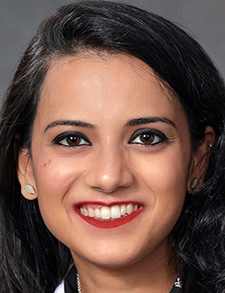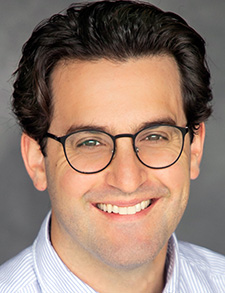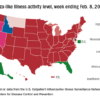Presenters and Summary authors: Matthew Shapiro, MD, MS, FAAP, Shuvani Sanyal, MD

Dr. Sanyal

Dr. Shapiro
As pediatric hospitalists, our organ is the hospital. We care for a wide variety of pathology in hospitalized children and work side-by-side with nearly every subspecialty, in both inpatient and outpatient settings. Through our clinical work and care coordination efforts, we directly feel the effects of our hospital systems and the societal powers that surround them. Thus, we are uniquely positioned to have strong connections to individual patients, the situations that brought them to us, and the care continuum they travel through.
In this article, we identify the top 10 publications of 2021, as presented at the Pediatric Update at SHM Converge 2022 in Nashville, Tenn., with summaries for five of those publications. We include clinical topics that may change how we practice as individuals, but also larger societal issues we can influence as hospital-based physicians.
Short-term Outcomes of the Study of Refeeding to Optimize Inpatient Gains for Patients with Anorexia Nervosa: A Multicenter Randomized Clinical Trial
Garber AK, et al. Short-term outcomes of the study of refeeding to optimize inpatient gains for patients with anorexia nervosa: a multicenter randomized clinical trial. JAMA Pediatr. 2021;175(1):19-27. doi:10.1001/jamapediatrics.2020.3359.
Background
Adolescents with anorexia nervosa and medical instability secondary to malnutrition are often hospitalized for short-term refeeding to restore vital sign stability.1 The standard of care for inpatient refeeding has been lower-calorie refeeding (LCR), typically starting at 1200 kcal/d and increasing slowly.2 LCR is generally considered safe and effective in avoiding refeeding syndrome but is associated with slow weight gain3 and long hospital stays.4,5 Higher-calorie refeeding (HCR), loosely defined to start at 1400 kcal/d, has been investigated in the past.6
Findings
This multicenter, randomized, controlled trial compared the safety, efficacy, and cost of LCR versus HCR. The LCR group started with 1400 kcal/d and increased by 200 kcal every other day. The HCR group started with 2000 kcal/d and increased by 200 kcal every day. They excluded patients with 60% or lower minimum body mass index (mBMI). Medical stability, defined as restoration of vital sign stability and mBMI of 75% or more for age and sex, was restored significantly faster with HCR compared with LCR (hazard ratio 1.67). HCR restored medical stability three days earlier and restored heart rate among those with bradycardia four days earlier. The hospitalizations for the HCR group were four days shorter and significantly less costly (savings of $5,518 per participant in cost and $19,056 in hospital charges). There was no difference in safety outcomes, defined as the incidence of electrolyte disturbances or requirement of electrolyte supplementation.
Impact to Practice
This study shows that HCR in particular patients with anorexia nervosa and medical instability secondary to malnutrition is safe, more effective, and less costly. Pediatric hospitalists who care for this population and use LCR strategies should consider altering their treatment to provide more effective and patient-centered care without sacrificing safety. Of note, this group published a one-year follow-up article that showed that HCR and LCR led to similar remission rates, medical rehospitalization rates within one-year post-discharge, number of rehospitalizations, and the total number of days re-hospitalized.7 This suggests HCR is equally effective from a more long-term view.
Hospital Outcomes for Children with Severe Sepsis in the USA by Race or Ethnicity and Insurance Status: A Population-Based, Retrospective Cohort Study
Mitchell HK, et al. Hospital outcomes for children with severe sepsis in the USA by race or ethnicity and insurance status: a population-based, retrospective cohort study. Lancet Child Adolesc Health. 2021;5(2):103-112. doi:10.1016/S2352-4642(20)30341-2.
Background
Sepsis is costly8 and is a leading cause of morbidity and mortality in children.9 There are disparities in the incidence and outcomes of sepsis in adults related to socioeconomic status, race, and ethnicity, even when controlling for confounders.10 Rates of sepsis in adults are higher in low-income areas11 and in Black and Hispanic adults.11, 12 There is an increased risk of death from sepsis for Black patients11,13 and in those who are uninsured.14 Similar disparities have been described across a range of pediatric conditions, suggesting sepsis outcomes may be disparate in children as well.
Findings
In this large, population-based, retrospective cohort study using the Healthcare Cost and Utilization Project Kids’ Inpatient Database, investigators examined patients 0-20 years old with severe sepsis with or without shock based on ICD-10 codes. When controlling for patient and hospital characteristics, they found that Black children had higher odds of death than did white children (aOR 1.19), driven by higher Black mortality in the south (aOR 1.30) and west (1.58). There was increased mortality for self-pay insurance or patients with no charge or “other” insurance status (aOR 1.30). They also found that there were longer hospital stays for Hispanic children (aHR 0.94) and Black children (aHR 0.88), particularly Black neonates (aHR 0.53).
Impact to Practice
This article provides evidence of the lack of equitable care in the U.S. It should help hospitalists acknowledge our individual implicit biases and encourage us to build more equitable care processes at our home institutions through introspective improvement of ourselves and our systems.
Hospital Consultation from Outpatient Clinicians for Medically Complex Children: A Randomized Clinical Trial
Mosquera RA, et al. Hospital consultation from outpatient clinicians for medically complex children: a randomized clinical trial. JAMA Pediatr. 2021;175(1):e205026. doi:10.1001/jamapediatrics.2020.5026
Background
Children with medical complexity (CMC) constitute only 0.4% of the total pediatric population,15 but they experience around 25% of all hospital days, more than 40% of inpatient deaths,16 and 53% of hospital charges.17 Continuity of care is particularly important for children with complex chronic conditions associated with technology dependence, multiple medications, and specialist care. Pediatric hospitalists, who may be unfamiliar with these patients or their outpatient management, face challenges in providing effective inpatient care when CMC are hospitalized for exacerbations of chronic conditions or acute illnesses.18
Findings
This single-center, randomized, quality-improvement trial assessed the impact of a hospital consultation service for CMC provided by their outpatient comprehensive care clinicians. Three hundred and forty-two high-risk CMC were randomized to either hospital consultation (HC, n = 167) or usual hospital care (UHC, n = 175). For the HC group, comprehensive care clinicians worked in close collaboration with patient families, emergency department staff, and hospital physicians on decisions of admission, inpatient care, and discharge planning. The control group (UHC) received routine care from hospitalists and resident teams. In the intention-to-treat analyses, hospital consultation reduced total hospital days by a Bayesian probability of 91% to 98%, compared to usual hospitalist care (2.72 versus 6.01 per child-year). The study also showed that the hospital consultation intervention had a 98% probability of reducing hospitalizations (0.60 versus 0.93 per child-year), 89% probability of reducing pediatric intensive care unit days (0.77 versus 1.89 per child-year), and 94% probability of reducing total health system costs ($24,928 versus $42,276 per child-year), compared to usual hospitalist care.
Impact to Practice
This randomized, quality-improvement trial demonstrated that hospital consultation by outpatient comprehensive care clinicians improved health outcomes, costs, and health care utilization for high-risk children with medical complexity. Hospitals caring for children (or perhaps, even adults) with medical complexity may consider adopting and studying similar models of inpatient care that promote continuity, avoid unnecessary admissions and duplicate tests, and better facilitate the transition back to outpatient care.
Predicting the Need for Phototherapy After Discharge
Kuzniewicz MW, et al. Predicting the need for phototherapy after discharge. Pediatrics. 2021;147(5):e2020019778. doi:10.1542/peds.2020-019778.
Background
To evaluate the risk for neonatal hyperbilirubinemia, newborns routinely have their bilirubin assessed prior to nursery discharge. Per the American Academy of Pediatrics (AAP) hyperbilirubinemia guidelines,19,20 follow-up timing is determined by using the age-based Bhutani Nomogram,21 while a separate graph (based on neurotoxicity risk factors) informs decisions for phototherapy. The objective of this study was to develop and study predictive models—based on the difference between the pre-discharge total serum bilirubin (TSB) and AAP phototherapy thresholds (∆-TSB)—to determine the likelihood that a post-discharge TSB will exceed phototherapy thresholds.22
Findings
This large retrospective cohort study of 148,162 infants born at >35 weeks’ gestation at 11 Kaiser Permanente Northern California facilities compared three predictive models—the ∆-TSB, ∆-TSB-Plus (which included additional factors), and the Bhutani Nomogram—for their discernment of infants at risk for clinically significant hyperbilirubinemia. Two thousand six hundred and twenty-three infants (1.8%) had a post-discharge bilirubin level above the phototherapy threshold. The receiver operating characteristic curves showed that all three models performed well in predicting infants at risk for exceeding the phototherapy threshold before age 30 days. The ∆-TSB-Plus model had the highest area under the curve (AUC 0.95), followed closely by the ∆-TSB model (AUC 0.93), and the Bhutani Nomogram (AUC 0.88). The ∆-TSB and ∆-TSB-Plus models better predicted the likelihood and timing of exceeding phototherapy thresholds for infants at moderate risk for developing hyperbilirubinemia.
Impact to Practice
The two ∆-TSB models incorporate the total serum bilirubin level and timing of the initial test along with neurotoxicity risk factors of gestational age and isoimmune hemolytic disease. Therefore, only the AAP phototherapy threshold chart is needed to apply these predictive models. Pediatricians can use the ∆-TSB models to accurately determine the timing of follow-up testing and phototherapy based directly on the probability of exceeding phototherapy thresholds in 24 hours, 48 hours, or 30 days.
Clinical Practice Guideline: Evaluation and Management of Well-Appearing Febrile Infants 8 to 60 Days Old
Pantell RH, et al. Evaluation and management of well-appearing febrile infants 8 to 60 days old [published correction appears in Pediatrics. 2021;148(5):]. Pediatrics. 2021;148(2):e2021052228. doi:10.1542/peds.2021-052228.
Background
Since the 1970s when neonatal group B streptococcus infections were first recognized, there have been numerous attempts to determine appropriate workup and management for the young febrile infant. Many different approaches evolved, often leading to extensive evaluations, hospitalizations, and empiric antimicrobial treatments. There has long been a need for a consensus guideline that is current and evidence-based.23
Findings
A meticulous review of the literature by a committee of epidemiologists, general pediatricians, and pediatric subspecialists resulted in 21 action statements to guide the evaluation and management of well-appearing full-term febrile infants ages 8 to 60 days. The recommendations are summarized in three age-based algorithms—for infants 8 to 21 days of age, 22 to 28 days of age, and 29 to 60 days of age. Important considerations which shaped the new recommendations include the changing epidemiology of neonatal bacterial infections, from gram-positive to gram-negative predominance; increasing access to rapid and precise identification methods for bacterial and viral pathogens; and growing evidence elucidating how age impacts the risk and etiology of invasive bacterial infections in the first weeks of life. These key considerations inform new recommendations on obtaining inflammatory markers for the initial evaluation, deferring cerebrospinal fluid studies in certain older infants, and allowing home management when infants are determined to be at very low risk for a bacterial infection and families have received adequate education on return precautions.
Impact to Practice
This guideline offers step-by-step approaches to the evaluation and management of the well-appearing febrile infant. The authors note, however, that these recommendations are not to be viewed as an exclusive course of action, and that variability is appropriate given the availability of resources and shared decision-making with families. Clinicians should review the quality of evidence, benefit-harm relationship, and value judgments implicit in the recommendations with families before choosing the best course of action.
Dr. Shapiro is an assistant professor of pediatrics at the University of California Irvine School of Medicine and a fellowship-trained pediatric hospitalist at the Children’s Hospital of Orange County, Irvine, Calif. Dr. Sanyal is a current fellow in pediatric hospital medicine and clinical instructor of internal medicine at Baylor College of Medicine, Texas Children’s Hospital, Houston.
The remaining articles that comprised the top 10 include:
- Gender Distribution in Pediatric Hospital Medicine Leadership. Allan JM, et al. Gender distribution in pediatric hospital medicine leadership. J Hosp Med. 2021;16(1):31-3. doi:10.12788/jhm.3555.
- Quality Initiative to Reduce High-Flow Nasal Cannula Duration and Length of Stay in Bronchiolitis. Charvat C, et al. Quality initiative to reduce high-flow nasal cannula duration and length of stay in bronchiolitis. Hosp Pediatr. 2021;11(4):309-18. doi:10.1542/hpeds.2020-005306.
- Treatment of UTIs in Infants <2 Months: A Living Systematic Review. Nama N, et al. Treatment of UTIs in infants <2 months: a living systematic review. Hosp Pediatr. 2021;11(9):1017-30. doi:10.1542/hpeds.2021-005877.
- Multisystem Inflammatory Syndrome in Children—Initial Therapy and Outcomes. Son MBF, et al. Multisystem inflammatory syndrome in children—initial therapy and outcomes. N Engl J Med. 2021;385(1):23-34. doi:10.1056/NEJMoa2102605.
- Risk Factors and Outcomes After a Brief Resolved Unexplained Event: A Multicenter Study. Tieder JS, et al. Risk factors and outcomes after a brief resolved unexplained event: a multicenter study. Pediatrics. 2021;148(1):e2020036095. doi:10.1542/peds.2020-036095.
References
- Shamim T, et al. Resolution of vital sign instability: an objective measure of medical stability in anorexia nervosa. J Adolesc Health. 2003;32(1):73-7. doi:10.1016/S1054-139X(02)00533-5.
- American Dietetic Association. Position of the American Dietetic Association: Nutrition intervention in the treatment of anorexia nervosa, bulimia nervosa, and other eating disorders. J Am Diet Assoc. 2006;106(12):2073-82. doi:10.1016/j.jada.2006.09.007.
- Garber AK, et al. Higher calorie diets increase rate of weight gain and shorten hospital stay in hospitalized adolescents with anorexia nervosa. J Adolesc Health. 2013;53(5):579-84. doi:10.1016/j.jadohealth.2013.07.014.
- Garber AK, et al. A prospective examination of weight gain in hospitalized adolescents with anorexia nervosa on a recommended refeeding protocol. J Adolesc Health. 2012 Jan;50(1):24-9. doi:10.1016/j.jadohealth.2011.06.011
- Golden NH, et al. Higher caloric intake in hospitalized adolescents with anorexia nervosa is associated with reduced length of stay and no increased rate of refeeding syndrome. J Adolesc Health. 2013;53(5):573-8. doi:10.1016/j.jadohealth.2013.05.014.
- Garber AK, et al. A systematic review of approaches to refeeding in patients with anorexia nervosa. Int J Eat Disord. 2016;49(3):293-310. doi:10.1002/eat.22482.
- Golden NH, et al. Higher-Calorie refeeding in anorexia nervosa: 1-year outcomes from a randomized controlled trial. Pediatrics. 2021;147(4):e2020037135. doi:10.1542/peds.2020-037135.
- Carlton EF, et al. Cost of pediatric severe sepsis hospitalizations. JAMA Pediatr. 2019;173(10):986-7. doi:10.1001/jamapediatrics.2019.2570.
- de Souza DC, Machado FR. Epidemiology of pediatric septic shock. J Pediatr Intensive Care. 2019;8(1):3-10. doi:10.1055/s-0038-1676634.
- Jones, J. M., et al. Racial disparities in sepsis-related in-hospital mortality: using a broad case capture method and multivariate controls for clinical and hospital variables, 2004-2013. Crit Care Med. 2017;45(12):e1209–e1217. https://doi.org/10.1097/CCM.0000000000002699.
- Barnato AE, et al. Racial variation in the incidence, care, and outcomes of severe sepsis: analysis of population, patient, and hospital characteristics. Am J Respir Crit Care Med. 2008;177(3):279-84. doi:10.1164/rccm.200703-480OC.
- Dombrovskiy VY, et al. Occurrence and outcomes of sepsis: influence of race [Erratum in Crit Care Med. 2008 May;36(5):1699-700]. Crit Care Med. 2007;35(3):763-68. doi:10.1097/01.CCM.0000256726.80998.BF.
- Mayr FB, et al. Infection rate and acute organ dysfunction risk as explanations for racial differences in severe sepsis. JAMA. 2010;303(24):2495-503. doi:10.1001/jama.2010.851.
- Kumar G, et al. The association of lacking insurance with outcomes of severe sepsis: retrospective analysis of an administrative database. Crit Care Med. 2014;42(3):583-91. doi:10.1097/01.ccm.0000435667.15070.9c
- Kuo DZ, et al. A national profile of caregiver challenges among more medically complex children with special health care needs. Arch Pediatr Adolesc Med. 2011;165(11):1020-6. doi:10.1001/archpediatrics.2011.172.
- Simon TD, et al. Children with complex chronic conditions in inpatient hospital settings in the United States. Pediatrics. 2010;126(4):647-55. doi:10.1542/peds.2009-3266.
- Berry JG, et al. Inpatient growth and resource use in 28 children’s hospitals: a longitudinal, multi-institutional study. JAMA Pediatr. 2013;167(2):170-7. doi:10.1001/jamapediatrics.2013.432.
- Mosquera RA, et al. Hospital consultation from outpatient clinicians for medically complex children: a randomized clinical trial. JAMA Pediatr. 2021;175(1):e205026. doi:10.1001/jamapediatrics.2020.5026.
- American Academy of Pediatrics Subcommittee on Hyperbilirubinemia. Management of hyperbilirubinemia in the newborn infant 35 or more weeks of gestation [Erratum in Pediatrics. 2004 Oct;114(4):1138]. Pediatrics. 2004;114(1):297-316. doi:10.1542/peds.114.1.297.
- Maisels MJ, et al. Hyperbilirubinemia in the newborn infant > or =35 weeks’ gestation: an update with clarifications. Pediatrics. 2009;124(4):1193-8. doi:10.1542/peds.2009-0329.
- Bhutani VK, et al. Predictive ability of a predischarge hour-specific serum bilirubin for subsequent significant hyperbilirubinemia in healthy term and near-term newborns. Pediatrics. 1999;103(1):6-14. doi:10.1542/peds.103.1.6.
- Kuzniewicz MW, et al. Predicting the need for phototherapy after discharge. Pediatrics. 2021;147(5):e2020019778. doi:10.1542/peds.2020-019778.
- Pantell RH, et al. Evaluation and management of well-appearing febrile infants 8 to 60 days old [Erratum in Pediatrics. 2021;148(5):]. Pediatrics. 2021;148(2):e2021052228. doi:10.1542/peds.2021-052228.


